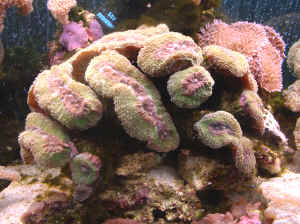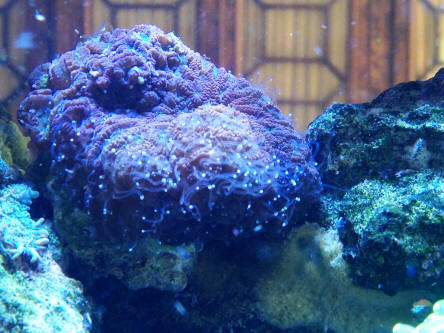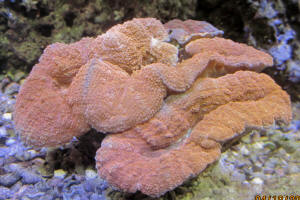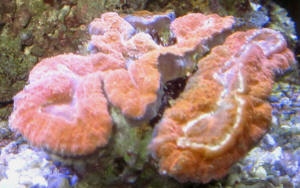|
FAQs about Mussid Coral
Behavior
Related Articles: Mussid Corals,
Related FAQs: Mussid FAQs 1, Mussid FAQs 2, Mussid Identification, Mussid Compatibility, Mussid Selection, Mussid Disease, Mussid Systems, Mussid Feeding, Mussid Reproduction, Stony/True Coral, Coral System Set-Up, Coral System Lighting, Stony Coral Identification, Stony Coral Selection, Coral Placement, Foods/Feeding/Nutrition, Disease/Health, Propagation, Growing Reef Corals,
Stony Coral
Behavior,
|

|
|
Mussid beh. 3/13/14
Hello WWM,
<Gian>
I trust you are well. I have been asking around for help to try and ID
this coral I purchased a few months back but can't seem to get a
definitive answer, I turn to you today with the hope that you can help
me solve this mystery. Its tentacles are often out but I am unsure if
this is a feeding response or if it is chemically sensing the small
Rhodactis (forgive my spelling) near by.
<Ah yes... these are mesenteric (sometimes labeled mesenterial)
filaments... Reaching out... "to touch someone" in a non-friendly
manner>
Regardless of this what I find fascinating about this coral, aside its
mysterious nature of not knowing what it is, is the fact that the
tentacles that are stretched out seem to sporadically lift themselves up
and "jiggle".
I can assure you that this is independent from currents in my aquarium,
in fact to make sure of this I turned all my pumps and filters off and
allowed my water to settle for several minuets before attentively
looking at the tentacles.
Together with the attached picture I am providing you with a link to
YouTube of a sort video showing said phenomenon. I had no idea corals
could do this....
https://www.youtube.com/watch?v=fyzD2bdFMeY
Kind regards
Gianfranco
<And you; Bob Fenner>
|

Re: re: Fwd: Mussid beh. f' What WWM is/not
3/13/14
Sooooo.... Do you have an ID for me? Brain coral?
<...? See WWM re Mussids. B>
|
ID; Mussid beh. f'
4/23/13
Hi Crew, I haven't bothered you for a while. Attached are pictures of a
Lobophelia (I Think).
<Does appear to be a member of the genus Lobophyllia>
The first is when lights were on and the second when off. The section on the
right is very open at night with feelers lining the opening. So is it a
Lobo?
<Yes and yes>
I used to have a very different one that was oval and the inner part was
blue and the outer part red and I never saw any feelers. Thanks, Sam
<... most stony corals feed principally during the night... when there's
more food items about, and less predators that might attack/consume their
soft parts while exposed... Many species, specimens can be/are trained to
"open" during the light hours in captivity... Understanzee? Bob Fenner> |

 |
Cynarina question, growth beh. 6/2/12
Hi Crew,
<Hi Sam>
I have a 24 gallon AquaPod with LED lighting. I have
six Acan colonies (10-50 heads), one candycane (25 heads), Two
Trachyphyllia (geoffrey and radiata) 4-6 inches, 1 torch (2"), 1
hammer(3") and frogspawn(4"), a Lobophyllia (3") and a Cynarina. The
Anthelia are the losers so far. Every few months I lose a head. But what
is there is very nice and full. I have most of these over 2 years at
least. A year ago I changed from T5 to LED.
The Acans really started growing many new heads as did my Blasto wellsly
(10 heads), which I forgot to mention. My question is about the
Cynarina.
It is green with a reddish brown center. When I got it and until I
changed my lighting it was very symmetrical. Now the lobes are very
large like balloons with many different shapes all going in different
directions. I have tried moving it but basically it stays the same.
Looks much nicer when symmetrical.
<One unique feature about this coral is its chameleon like ability which
enables it to change color and appearance due to changing
environmental or water conditions. In your case, your lighting has
changed.>
Thanks
<You're welcome. James (Salty Dog)>
Acan Coral Budding behavior 3/17/12
Hello All, I have searched your site and others like it and have been
unable to find an answer to my question.?
<Have you?>
I recently acquired a Acan frag from my LFS, when introduced to
my tank it looked great.?
<Did it or not?>
My water Param.s are nitrates 0, nitrites 0,
phoshates;.2, ammonia 0, calcium 500,
<Too high, and this and all other photosynthates need measurable NO3
and HPO4...>
temp 80, ph 8.1, Alk 13. It is a 29 gal tank
with 25 lbs live rock and Caribbean live sand.?
<What's w/ the ???>
I do 20% water changes weekly.? I had a hair algae outbreak a
while back and my Acan closed up, I got everything taken care of,
reduced feedings and lowered photoperiod as well as scrubbed the LR in
a old tank water bath.?
Did a 50% water change and all has been great since then.? My
Acan, Bubble,
<Likely the allelopathogenic winner here... the Acanthastrea
losing>
Sun corals are loving it as well as my polyps and
mushrooms.?
<These too>
When the Acan reopened there were two new heads on it,
needless to say I was overjoyed.?
<Mmm, I wouldn't be... too likely
"stress-related"...>
Now, its partially closed and I am very nervous again.? Is it closing
up a part of its budding process or is this just a coincidence?? Any
help you can give will be appreciated, your website is very
informative.?Thank you for all you do.
<... See/read on WWM re the above issues... soluble nutrients,
Cnidarian allelopathy. Short/est answer; If I had another established
system, I'd be moving this Mussid. Bob Fenner>
Dented brain
behavior 8/18/11
Hi I have an odd question. I have a dented brain coral in my reef tank.
All parameters are good. Lately I've noticed that at night the
dented brains mesenterial filaments come out at night and at night
only.
<Normal behavior... fighting for space, foods>
But during the day hours he's opened and puffy. Nothing has changed
in the tank or moved around. The coral just started to do this this
week and like I said its only at night. What would cause this and why
only at night and not during the day.
<Please read here: http://wetwebmedia.com/CorlCompArt.htm
and the linked files above, part. for Mussids. Bob
Fenner>
Scolymia, Hlth., reading
2/15/11
<... where is your grammar Dan?>
dear crew
i received a scolymia about 2 months ago. when i got it , it was about
12inch in diameter when full expanded.
<Wow!>
a couple of days ago it started to retract . it now only covers its
hard skeleton. i did a water change once i noticed it retracting, and
i'm in the process of doing another one. all my other corals
LPS
<These are likely at play.... Allelopathy>
and Clam are doing fine, fish as well. here are my parameters,
Ca 420
ALk 177 ppm
Mg 1300
1.025 salinty
NO3 - 0
<Need some>
PO4 -.05
any thought on whats going on or how to fix the problem? is it normal
for a scolymia to through cycles of expanding and retracting during the
day?
thanks in advance
Dan
<Read here: http://wetwebmedia.com/MussidDisF4.htm
and the linked files above, and: http://wetwebmedia.com/cnidcompppt.htm
and... Bob Fenner>
Re: Scolymia- 2/16/11
Thank you for the information. If it is chemical warfare that is
causing the Scolymia to retract which one of these corals is a possible
culprit?
<Yes>
Favia, Xenia, Ricordea, pink BTA, green BTA, frog spawn, various
Zoanthids.
Other then running carbon filtration, doing water changes and removing
the suspect coral is there anything else I can do?
<... read where you were referred to. The best would be to remove
the Mussid to another system, "condition" it to the presence
of the other Cnidarians through partial water changes for weeks>
I don't think it could be the Zoanthids as most of them came from
the same tank as the Scolymia.
Any help would greatly be appreciated,
with thanks
Dan
<Keep reading. BobF>
Re: Scolymia- 2/16/11
oh yeah I also have some green star polyps
<... also high on the "noxious" list. B>
Rainbow Acans Losing Color 6/28/10
Hi-
<Hello>
I picked up some freshly fragged rainbow style Acans a while ago. They
were placed into my Nano tank while my 180 was prepped. The lighting
consisted of a 150 MH and two 460 Actinic bulbs. The Acans were placed
on
the bottom with a total of 24" between the corals and the light.
They were in there for roughly three weeks before being moved to the
180. During this period, I expected the coloring to be evident, however
the corals just began
to turn a dark orange. The corals were growing, multiplying and eating,
however the rainbow color was basically gone. I moved the corals last
week into the 180 and placed them on the bottom of the tank.
They're eating like
normal and appear to be fine but I would like for their original
rainbow coloring to return. The lighting for this tank consists of 250
MH's (20k) and 420 Actinics. From the light to the Acans in this
tank is 36."
<A long way... do you have a PAR meter, or can you borrow one to
test how much useful light there is where these frags are?>
Now with various reading across the internet, I've gathered that
too much light will cause Acans to lose their coloring via
darkening.
<Can... but the fragging itself, move to different circulation, many
aspects of water quality and other factors could account for what
you've observed>
I have a Bleeding Apple Scoly however that has thrived in both
environments without any darkening or bleaching issues. (Different
corals, but I was thinking it would apply for most LPS across the
board) My questions are these:
1. Will the additional 12" be enough to offset the light intensity
issue I faced in the Nano tank or is this negated by the extra 100
watts from the MH?
<Likely so... but I'd test for (PAR meter)... You want/need a
reading of at least 100>
2. I've read about shading the rainbow style Acans via an overhang.
I have a few areas in the tank that have these overhangs, but placement
under them means the coral is completely shaded. Logic would tell me
that this would
eliminate the ability for the coral to complete photosynthesis. Is this
correct or would placing the Acans in the shade just mean they would
take in ambient light for this purpose?
<I would not shade the genus Acanthastrea thus>
Would I need to place the coral half in the light and half out if
possible? Also, I'm a bit lost in what the term "indirect
light" means.
<Reflection mainly>
3. The lighting system is approximately 12 " from the top of the
water. I want to have a mixed reef with SPS and LPS. Is my light too
close to the tank?
<It is not... in fact, a foot or so is about ideal for situation of
MH fixtures from water surface... for dispersion, allowance for heat
dispersion, avoiding splash and spray issues>
Thanks for any help that you can provide.
-Alex
<Perhaps a read here: http://wetwebmedia.com/MussidDisF4.htm
and the linked files above. Bob Fenner>
Acans/Behavior 5/4/10
Hi crew,
<Hiya Sam>
Lately I have been buying Acans (not sure how to spell the full
name).
<Acanthastrea>
5 are orange/red with white or blue and one is blue and green. So far I
am pleased with them and they seem to like their new environment which
is mostly candycanes in a 24 gallon Aquapod plus a Favite and a hammer
with 10 heads. They open up like the candycanes after lights are out
with their little feeder tentacles. I keep the Favite a distance from
the others because when I first got it there were this huge sweeper
tentacles like 6 inch spaghetti waving around. I have the Favite a year
now and rarely see those sweepers. The Acans have been in my tank for
about 3 months and yesterday I saw something for the first time. I
first thought the Acan was expelling stuff but when I looked closer it
was hair like red threads swaying in the breeze and they were not
coming out of the mouths. This Acan has about 20 heads and is about 6-7
inches from another coral and it almost reached it. I assume these were
sweeper tentacles but I can't imagine such thin little hairs doing
much damage.
<Oh, can do plenty of damage. What you are seeing are mesenterial
filaments and can digest organisms within reach, so be careful with
placement and distance between other corals.
They should be fed at night since this is when they usually extend
their feeder tentacles and/or mesenterial filaments.>
I few weeks ago I asked about the id of a coral. I wasn't sure if
it was a Blastomussa wellsi or what. I can now see 3 more heads
starting to grow under the one head that I have. When it gets bigger I
will take another picture and see if that helps identify it.
<Sounds good.>
Thanks,
<You're welcome. James (Salty Dog)>
Sam
Cynarina with white bubble
6/22/06 My Cynarina blossoms daily, expanding to more than twice
her night time size and looks more like light pink and green tinged
bubble coral than many of the pictures that show the central mouth
clearly exposed. I have had her well over a year (initially
she did look like the flatter photos) and she seems to have done very
well feeding almost exclusively on daily target fed black
worms. I recently (for about 3 weeks now) started feeding
frozen Mysis (thawed and enriched) to my seahorses in the same tank but
do not directly feed the Cynarina the shrimp. Yesterday I
noticed a strange white "polyp" showing from the center of
the other bubbles. The white bubble has a mouth like opening
and two black dots on either side of the opening so that it almost
looks like a dead fish head with eyes perpendicular to the mouth.
<Neat... might be a "lure"> There is no sign of
damaged/torn tissue. I have read that they don't
propagate in aquariums so I assume there is a problem. <Mmm, I
wouldn't> Is this a sign of
infection? What is my best course of action (if any) to keep
her healthy? The attached picture is a nighttime shot that clearly
shows the white bubble as it does not deflate at lights out. Thanks!
Denise <I would do nothing out of your current regimen here. Bob
Fenner>
Question on a (Lobophyllia) brain coral - 2/21/2006 Hi
WWM crew!. I have a question on a Lobophyllia brain coral that i
recently purchased. My question is, I've noticed that this coral
has small orifices on its polyps ( largest polyp has 4 ). Well some
times these orifices will open up and the coral will deflate, then
reinflate with in a few minutes. Now is this some sort of water
exchange?. <Among other things...> Also when it deflates i can
see the skeleton ( spines ) kinda poking through. Is this something i
should be concerned about?. <...? No... Mussids do get
"fuller" polyps at times, reacting...> Please, any help
would be appreciated!. Oh and one final thing. Love your web site,
always have, always will!. Roger. <Bob Fenner> Scolymia
I have a Scolymia in my 29 gallon reef aquarium. I have had him
for about five months, and he doesn't seem to be acting like he
used to. I feed him frozen krill. His mouth opens up when he is hungry,
but lately, he is constantly keeping it open. After I place a creel in
his mouth, he does not want to eat it anymore. He looks a lot skinnier
in the mouth area than he usually did. He used to be big and plump in
the middle. Some additional products I add to the tank is Chromaplex,
Zooplex, Iodine, Reef Buster, and PhytoPlex. I also have exceptional
lighting (Coralife light). What can be making the Scolymia act the way
he has been lately? Also, are there any other helpful hints I may need
to know about the Scolymia eating habits. <How large are the krill
you're feeding? If you're feeding whole krill, then the animal
is probably declining from starvation. Feeding such large portions is
unnatural, and is not usually digestible by any Cnidarian. They engulf
it, for sure, but expel it later, and acquire virtually nothing from
the food item. Feed small minced portions no larger than 1\4"
across, and VARY the diet! Try Mysis, prepared foods, scallops, fish,
Cyclop-Eeze, etc. Also, soak the food in a HUFA\OMEGA3 supplement such
as Selcon> Thank you, <You're welcome, and good luck!>
Holly <M. Maddox>
Do brain Corals poop? Hello Bob, Anthony, whomever has the
pleasure of answering this question, <I guess I'm going to be
the poop expert today... no different than any other day...hehe> So,
I just got my lovely pineapple brain for my tank, and I've notice a
curious occurrence, <Blastomussa or Faviid species?> It looks
like it poops <they all do if you are feeding meaty foods
regularly> every day, the individual colonies seem to take their
turns ejecting this long brown stringy stuff, <if you are not
feeding meaty foods and didn't quarantine or acclimate this coral
to the new light up a gradient over time (just put it in the top 1/3 of
the tank right off the bat...aiee!!!) then you could be looking at a
possibly fatal expulsion of zooxanthellae packets (bleaching event)>
the coral seems to do it one section at a time. Now, they don't
look like they are spawning, and since its been in my tank for only 4
days, I doubt that's what its doing, but I was wondering if this is
actually how corals get rid of their waste? Any ideas? Thanks!!! David
<I realize in four days that you did not QT or otherwise acclimate
this coral to light. If it is Blastomussa wellsi in the top third of
the tank, you are bleaching and killing it. It is a true Faviid species
it is likely to want the bright light after a gradual acclimation from
the stress of import. What kind of light do you have and how long on?
MH?...then is likely a bad sign. But if weaker lights, perhaps not.
kindly, Anthony>
Re: Do brain Corals poop? Hey, so, I have 32W Power compact,
1/2 daylight, 1/2 actinic, (Sealife Retrofit for my eclipse hood) and a
Faviid Brain its in a 25gal tank, and probably 12 in from the top.
<not at all too bright...for some Faviids, enough indeed. We can
safely rule out bleaching> I'm the same guy with the Yellow
polyps and green button polyps, <my apologies David, I didn't
recall at first> for the 1st day I had the coral probably 4 inches
lower in the tank, and then moved it up a little. <very
good...and can go to the very top eventually if you like under these
lights> I've been feeding the tank 1/2-1 cube of frozen mysis
shrimp, which I try to mash up a bit, every day, <very good!> and
there's a bicolor blenny and firefish goby in the tank. The light
are set to about 10 hours on, 14 hours off. no dawn or dusk, <no
problem...fine> usually the polyps though take advantage of my large
windows and are pointing out toward them in the morning. <too
cool... and telling you that you need to set up a greenhouse for coral
farming...hehe. Or at least a bay window!> I see the coral putting
out its feeder tentacles about twice a day, no bleaching as of yet...
So that's what's going on... so do you think it pooping or
bleaching? <Without a doubt... related to the legend of why a bear
brings a Reader's Digest into the woods <G>> Thanks again
Anthony David <my pleasure, goombah. Anthony>
-Scolymia showing teeth!- Dear Bob, <Kevin here in his
stead> I have had a Scolymia for about 2 months. It feeds nicely
-almost every other day on bits of lancefish nicely soaked in Selcon
and Zoë. Originally it didn't have any 'toothy'
extensions or they were all entirely covered by the flesh. I
have noticed that now one or two protrude. <Likely from some sort of
light damage> It inflates nicely and eats avidly, if slowly -about
25 minutes- what I provide. <That's a good sign> It is in
good light, slight water motion and no nasty neighbors that would
sting. I was a bit worried that the toothy extensions through the flesh
my signal some kind of unhappiness or decay. <The toothy extensions
are it's septa which have pierced the flesh somehow, likely from
some sort of light trauma. If it does not become infected at the spot
where the flesh has torn, it should heal nicely. The only problem with
the septa sticking out is the possibility for an encroaching algae to
develop and push the tissue back further. Keep an eye out for this.>
I like it very much and it is a coral now no longer imported in the UK
<Really?! Why is this?> so I am especially keen to see it do
well. Am I worrying too much? or is there something wrong? Thanks for
all the help on your fab site. <Good luck! -Kevin> Massimo

